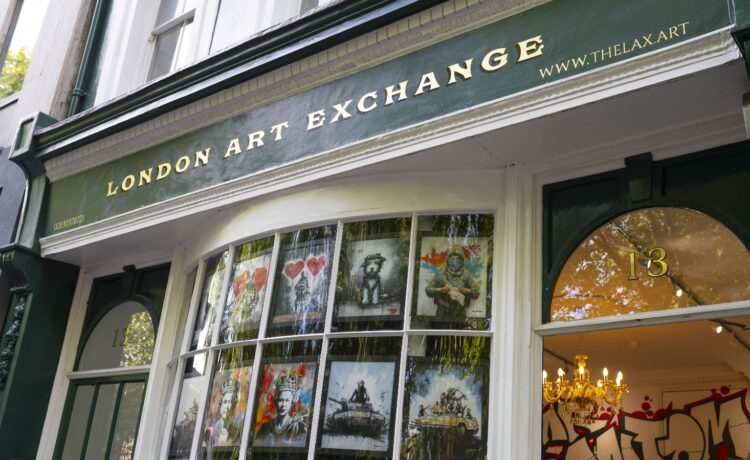When William Rose walks into the London Art Exchange’s glass-fronted offices at 13 Soho Square, the atmosphere seems to shift. He carries with him not only fifteen years of experience in financial markets but also the unusual conviction that art is not just culture—it is capital. As Senior Portfolio Manager and Head of the Institutional Division, Rose has become one of the most distinctive figures in London’s evolving art-investment scene: part broker, part strategist, part custodian of legacies.
From Commodities to Canvases
Roses career began far from gallery walls. For over a decade, he cut his teeth in commodities and financial markets, mastering the nuances of tax-efficient structures, portfolio balancing, and risk management. He speaks the language of analysts, not curators, yet this background is precisely what drew the attention of London Art Exchange (LAX).
Two years ago, he was headhunted by CEO Kylie Susan James to spearhead the institutional wing of a gallery that was already making waves for its hybrid model: part traditional exhibition space, part online investment platform. Where other galleries leaned on heritage or spectacle, LAX was unapologetically building a bridge between collectors and capital markets. Rose, with his background in commodities, was the missing piece.
“I didn’t arrive here to reinvent art,” he says. “I arrived to reframe how art can function as an asset class—a tangible one that holds weight when equities crumble.”
London Art Exchange: A Gallery With Algorithms
The London Art Exchange positions itself at the crossroads of art, finance, and accessibility. Unlike Sotheby’s or Christie’s, it doesn’t aim to cater solely to the upper one percent. Nor does it operate like mass online platforms such as Saatchi Art, where curation often takes a back seat to volume. Instead, LAX mixes exclusivity with accessibility: representing artists under long-term contracts, offering limited-edition series, and building tailored portfolios for both private and corporate clients.
Behind the scenes, Rose oversees some of the Exchange’s most ambitious financial structures. These include the Supplementary Art Ownership Guide (SAOG), an entry-level portfolio program priced around £100,000, and the Shadow Trust Portfolio (STP1738), a trust-like structure requiring a £250,000 minimum buy-in designed for high-net-worth individuals.
Perhaps most intriguingly, Rose has championed LAX’s Black Box Trading System—a proprietary algorithm that parses decades of art-market data, economic indicators, and external platforms like Artsy and Artnet. According to internal tests, the algorithm has achieved a 92% success accuracy rate in forecasting appreciation potential. Harrison is cautious about the figure, wary of overselling. “Models are only as good as the assumptions they rest on,” he says. “But in volatile times, having a systematic lens is better than navigating blind.”
The Broader Market: Tangible Assets in Uncertain Times
The timing of Rose’s tenure is not accidental. The past decade has seen both the fragility of traditional portfolios and the rise of “tangible wealth.” In periods when equities wobble and currencies strain, collectors often pivot toward real estate, precious metals, or wine. Art, long seen as a rarefied indulgence, has increasingly entered this conversation.
Harrison argues that art offers something the others do not: cultural dividend alongside financial return. “Owning a gold bar won’t start a dinner conversation,” he notes. “A painting by Gabrielle Malak or Pierre Simone will. That duality—emotional and economic—is what makes art resilient.”
LAX’s client base reflects this shift. While the gallery’s walls display works from figures such as Mark Kostabi, Peter Max, and Michael Godard, the sales floor also accommodates rotating installations for corporate clients—hotels, financial firms, and luxury brands who want art as part of their customer experience. Under the stewardship of Rose’s colleagues, such as Giselle Cohen in corporate placements, LAX has built a model that expands beyond the traditional gallery transaction.
A Broker’s Toolkit: Persuasion, Scarcity, and Legacy
Internally, Rose is also a mentor. He plays a role in LAX’s SWWAG training framework, which equips brokers not only with knowledge of silver, whisky, wine, art, and gold, but also with the psychology of persuasion. William is quick to clarify: this is not the boiler-room stereotype of aggressive sales. Instead, the emphasis is on rapport, transparency, and ethical urgency.
“Clients know when they’re being oversold,” he says. “Our job is not to create fear of missing out. It’s to explain how scarcity—when managed responsibly—creates value. Limited editions, exclusive contracts, curated collections: these are tools of preservation, not gimmicks.”
The London Art Exchange pushes brokers to see themselves less as salespeople and more as partners in legacy building. This message, according to internal surveys, resonates: client satisfaction reportedly sits at 97 percent.
Artists in the Frame
While Rose spends much of his time with numbers and structures, he insists the artists remain at the core. LAX’s roster includes established names alongside rising figures such as Gabrielle Malak—dubbed “the French provocateur” for her textured explorations of femininity—and the enigmatic street artist Mr Phantom, whose works carry both activist undertones and high market demand.
“Every algorithm in the world won’t matter if you don’t believe in the artists,” Harrison says. “Our role is to ensure that belief is translated into portfolios that endure.”
It is this balancing act—between spreadsheets and canvases—that has become Rose’s signature. He can talk about liquidity ratios with the same fluency as he can describe Noah Harris’s animal-human hybrids or Christina Vegas’s surreal blossoms. To him, they are not separate languages but dialects of the same conversation.
Expansion and Ambition
Looking ahead, William and the LAX leadership team envision an ambitious trajectory: e-commerce platforms with AI-driven personalization, art leasing subscriptions for businesses, and geographic expansions to Dubai, Hong Kong, New York, and Paris.
Such plans are not without risk. The global art market remains cyclical, subject to economic downturns and shifting tastes. Yet Harrison seems undeterred. “Legacy businesses are never built in straight lines,” he says. “They’re built in cycles. Our role is to manage the downswings so that the upswings compound.”
Critics and Caution
Of course, the hybridization of art and finance attracts skepticism. Traditionalists worry that turning canvases into portfolio items risks stripping art of its cultural essence. Others note that projected returns—25 to 40 percent annual growth in some programs—rely heavily on past case studies and cannot be guaranteed in volatile markets.
William does not dismiss the critiques. Instead, he leans into them. “Skepticism is healthy,” he says. “It forces us to refine, to make sure we’re not selling illusions. I’d rather a client ask hard questions up front than discover soft promises later.”
This transparency may be what sets him apart from the stereotype of the art-investment advisor. In meetings, he is described as measured, not pushy; analytical, but still attuned to the aesthetics of the works in question. It is a rare blend, and one that has become increasingly necessary in a market where credibility is currency.
Legacy as the Final Word
At its heart, the London Art Exchange presents itself as more than a gallery—it is a platform for legacy creation. For William, that message is personal. After years in finance where assets were abstract, his move into art feels tangible, human. He recalls a collector who recently acquired a portfolio designed for multi-generational transfer. “This wasn’t just an investment,” Rose reflects. “It was a grandfather planning for his granddaughter’s education and her cultural inheritance. That’s when you realize art can outlive us in more ways than one.”
Conclusion
William Rose’s story is not simply about a financier entering the art world. It is about a wider cultural moment in which art and finance are converging in new and sometimes controversial ways. Whether the London Art Exchange ultimately fulfills its bold projections remains to be seen. But William’s presence—analytical, cautious, yet quietly ambitious—suggests that the company is intent on navigating that convergence with both rigor and imagination.
At 13 Soho Square, among the canvases and contracts, the future of art as an asset class is being written—and William is holding the pen.



